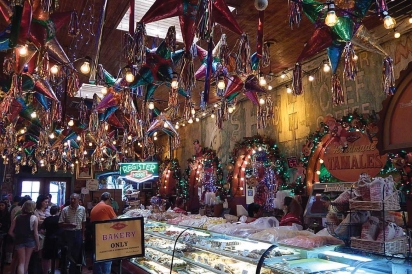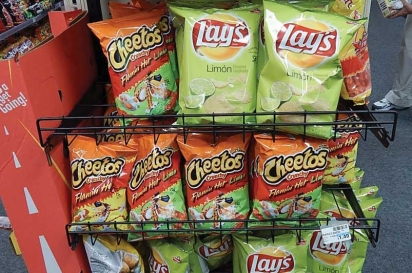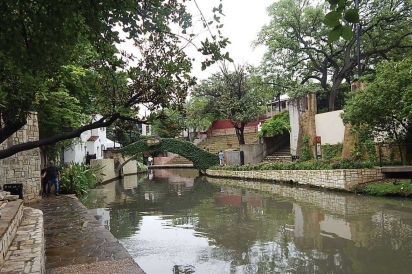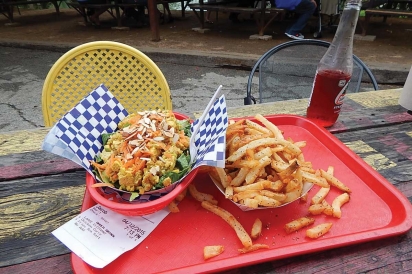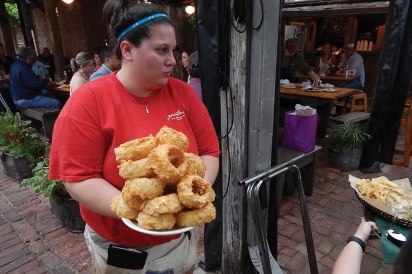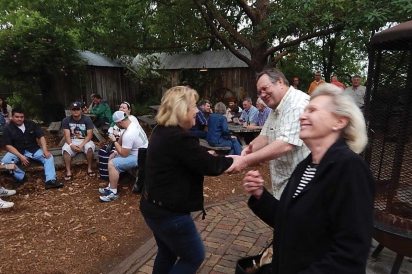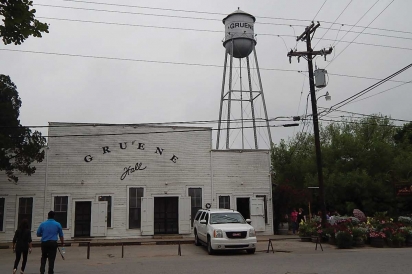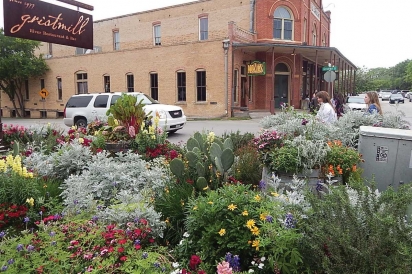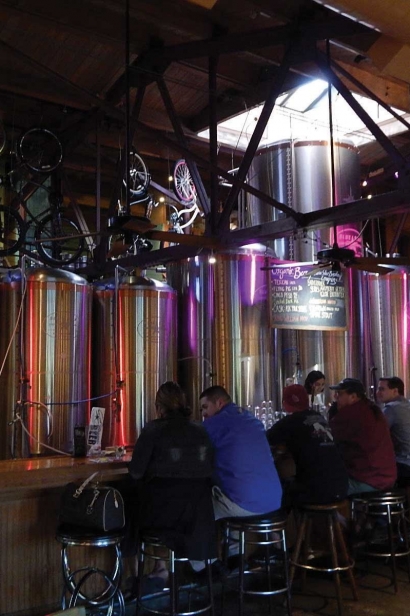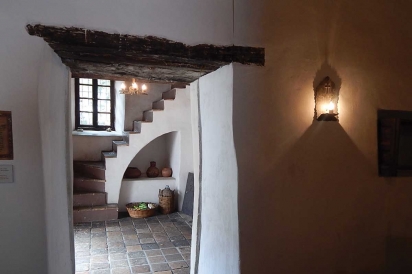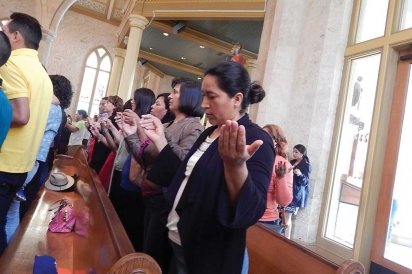The Accidental Vegetarian Does the Texas Hill Country
In the beginning there were long periods of shimmering heat punctuated by torrential downpours. As a consolation prize, the Gods of the Tonkawa gave them lime, salt, and chili pepper with the provision that they had to put all three on everything, and serve it with live music and libations.
This may explain how I came to order a small plate of chopped watermelon and was asked if I wanted to put chili pepper, lime and salt on it. Fruits and vegetables have always been suspect in Texas. That dish of green beans goes undercover behind a tall hat, mustache, and dark glasses of deep fried batter, cheese, butter, bacon, slivered almonds… and chili pepper, lime and salt. The same could go for any vegetable and some of the veggie cousins, such as fish. Anything that grows in the ground, as opposed to on it, is integrated into Texas society this way. In the San Antonio Mercado, I ordered a piña colada, described as pure coconut, served in a hollowed out pineapple. This time, I asked for some lime (because you put the lime in the coconut) and received a quizzical expression. Three fruits together is a conspiracy. The drink came out with whipped cream and chocolate drizzle on top.
I’m not the kind of food writer that has the gift of effortlessly finding funky, forgotten roadside places with tempting local cuisine every time I stop for gas. My interest is documenting how you and I actually eat along the road, no matter whether it’s at a sit down restaurant or a vending machine in a laundromat. I’d love to tell you about the historical origins of quirky regional specialties in Texas, but I’m going to come clean about what we actually ate, which may prepare you for your experience in the real world of Texas cuisine. For instance, lunch one day was a scoop of chocolate ice cream and two chocolate dipped strawberries. This was followed by a long hike out on the San Antonio River Walk with no restaurants in sight, until finally when we were starving and it was nearly dark, we came upon a modern food complex.
These can be recognized as part food truck, part biergarten, and part recycling and nailing together of any wood or metal object that happens to be lying around and free. For some reason, not wanting to eat any meat in the land of cattle, we ordered an “off menu” combo that I would have titled, “The Eight Year Old” had it actually been on the menu – a side of fries with chili pepper, lime and salt, and a strawberry soda. Ok, the soda got hipster points for being imported. And instead of calling our name or number, we were handed a large plastic dinosaur so the server could identify our location. Ducks came up from the river bank and went under the picnic tables, where they also managed to fight over and survive on chili fries. I ordered a chicken salad, which as a California greenhorn, I actually envisioned as being made of lettuce. Not saying I didn’t sort of enjoy it, but I think it was cubes of chili pepper, lime, salt and mayonnaise.
Our favorite place in Austin was the Driskill. This is a large 19th century hotel, recently renovated in what I would call Western Gilded Age, a mix of fru fru architectural elements and leather sofas made of real furry cow hide. And there on the appetizer menu in the lounge, the Accidental Vegetarian was thrilled to discover a dish composed entirely of Brussel sprouts. By now you probably realize that in Texas, naked on a vegetable is about as acceptable as naked would have been on a person in the Victorian era. By the time this sprout had been tarred and feathered with butter, oil, teriyaki, Worcester sauce, almonds, raisins and who knows whatall, it would take a month on a mechanical bull to twist it off. The city slogan is “Keep Austin weird. ” What could this mean? As we exited the theater one night, a guy came strolling down the street in a cowboy hat, a purple cape, 1970s style oversized glasses, cowboy boots, and a teeny weeny purple bikini. I guess the shirt and pants were still at the dry cleaners.’
New Braunfels was hard to locate. The historical part of town is now written as ‘Gruene’ but is pronounced, “Green. ” You’re supposed to drive around in the countryside under a tree canopy and spot the name on a water tower. Anywhere else a historical town reached by windy roads through the woods and featuring bars, dance halls, beer gardens, and bands belting out the blues would be rattling with idling motorcycles. But this is a very mellow place, with antique stores and bed-and breakfasts. The adults seemed to have left the kids with Aunt Ipad and gone out to a paradise of open carry beer. There are several nice restaurants in the handful of blocks that make up the heart of this town, and we chose the Gristmill. This is a very large establishment, sprawling along the side of a hill above the Guadalupe River. It looks like it was patched together over time by local carpenters not working from a master plan. The fireplace in one room is decorated with three boars’ heads, in another room, a longhorn bull. You wait for a table next door in the beer garden where there are so many people ahead of you that it takes four full time folks just to write down the names on a chalk board and then cross them out. Once in, we tried the trout in chili pepper, lime and salt, with a half order of six onion rings that stood a foot tall.
On to San Antonio’s La Villita Arts Village where we encountered the town’s new regional specialty, the breakfast taco. At $1.95 a taco this is a cheap way to start the day, with a rolled up flour tortilla containing your preferred combination of eggs, potato, cheese, bacon and sausage. In So Cal, anything in a flour tortilla is called a burrito, not a taco. The flour tortilla itself is a postwar invention, so whether Jack in a Box inspired this regional cuisine, I’m not sure.
One day we River Walked right out of town, past the King William historic home district and to the end of the landscaping, where the river becomes natural again. From here you can rent bicycles and continue in an eight mile loop downstream to see four Spanish missions. At the intersection of the man-made and natural worlds is the Blue Star Arts Complex, containing art galleries, a bike shop, bars, coffee houses and restaurants. You can see the tanks in the Blue Star Brewery and sample the product in a bar full of bikers - that is, bicycle bikers. Once again I went for the chicken salad because it’s like a lottery where the winner might find some lettuce. This time I won.
Meanwhile, back at the hotel, the snacks were not hidden in the minibar fridge but covered half the top of the dresser, daring you to resist. So late at night, we would cut a swath of devastation, leaving only a pile of wrappers in the trash can. Then we would rearrange the remaining snacks to look like no one had touched them, to avoid the overpriced fee. It’s all about intentions, and no hotel should charge you for what you intended not to eat. A minibar is to a guest as a highway patrol is to speeding cars. There should be an entrapment defense.
Post-Indian Texas cuisine began with the French Colonists under La Salle starving to death when their supply ship sank in Matagorda Bay. During the Battle of the Alamo, cattle were herded in and roasted by the defenders. Mexican American food originated in San Antonio in the 1890s, by women selling homemade tamales from steaming pots on the sidewalk. Nowadays the cuisine of all nations is welcomed as long as they abide by the Statewide Convention prohibiting undecorated vegetables. Do not do as we did and try to maintain a strict vegetable and chocolate diet. For God’s sake, there’s authentic Tex-Mex food - cheese enchiladas smothered in sauce with more cheese on top. There are places like The Salt Lick, serving heaping mounds of smoked brisket, steak, chops and sausage. There is a whole closed off street of bars serving Texas beer and hard liquor in Austin. As the Texas settler slogan goes, “Come and Take It.”



